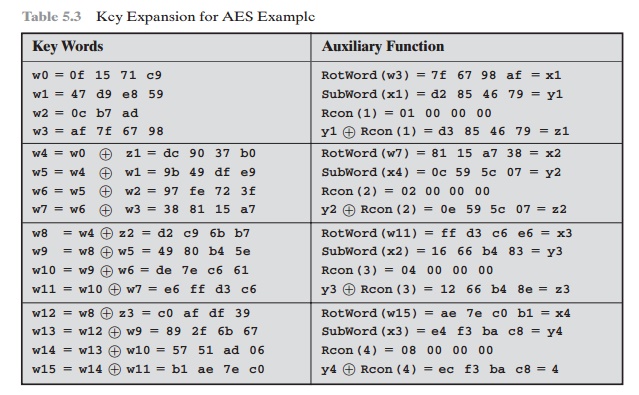Chapter: Cryptography and Network Security Principles and Practice : One Symmetric Ciphers : Advanced Encryption Standard
An Advanced Encryption Standard(AES) Example
AN
AES EXAMPLE
We now work through an example and consider some of its implications.
Although you are not expected to duplicate the example by hand, you will find
it informative to study the hex patterns that occur from one step to the next.
For this example, the plaintext is a hexadecimal palindrome. The plaintext, key, and
resulting ciphertext are
Plaintext: 0123456789abcdeffedcba9876543210
Key: 0f1571c947d9e8590cb7add6af7f6798
Ciphertext: ff0b844a0853bf7c6934ab4364148fb9
Results
Table 5.3 shows
the expansion of the 16-byte
key into 10 round keys. As previously
explained, this process
is performed word
by word, with
each four-byte word occupy- ing one column of the word round-key matrix.
The left-hand column shows the four round-key words generated for each round.
The right-hand column shows
the steps
Table
5.3 Key Expansion for AES Example


used to generate
the auxiliary word used in key expansion. We begin,
of course, with the key itself serving
as the round key for round 0.
Next, Table
5.4 shows the progression of State
through the AES encryption process. The first column shows the value of State at the start of a round. For the first
row, State is
just the matrix
arrangement of the
plaintext.The second, third,
and fourth columns show the value of State for that round after
the SubBytes, ShiftRows, and MixColumns transformations, respectively. The fifth
column shows the round key. You can verify
that these round
keys equate with those shown
in Table 5.3. The first column shows the value
of State resulting from the bitwise
XOR of State after the preceding MixColumns with the round
key for the
preceding round.
Avalanche Effect
If a small change in the key or plaintext
were to produce a corresponding small change in the ciphertext, this might be
used to effectively reduce the size of the



plaintext (or key) space to be searched.
What is desired is the avalanche effect, in which a small change in plaintext or key produces a large
change in the ciphertext.
Using the example
from Table 5.4, Table 5.5 shows the result when the eighth bit of the plaintext is changed.
The second column of the table shows the value of the State matrix at the end of each round for the two plaintexts. Note that after just
one round, 20 bits of the State vector differ. After two rounds, close to half the bits differ.
This magnitude of difference propagates through the remaining
rounds. A bit difference in approximately half the positions in the most desirable outcome. Clearly, if almost all
the bits are changed,
this would be logically equivalent to almost
none of the bits being changed. Put another way, if we select two plaintexts
at random, we would expect the two plaintexts to
differ in about half of the bit positions and the two ciphertexts to also differ
in about half the positions.
Table 5.6 shows
the change in State matrix
values when the same plaintext is used and the two keys differ in the eighth bit. That
is, for the second case, the key
is 0e1571c947d9e8590cb7add6af7f6798. Again, one round produces a
Table
5.5 Avalanche Effect in AES: Change in Plaintext



significant change, and the magnitude of change after all subsequent rounds is roughly half the bits. Thus, based on this example, AES exhibits a very strong avalanche effect.
Note that this
avalanche effect is stronger than that for DES (Table
3.5), which requires three rounds to reach a point at which approximately
half
the bits are changed, both for a bit change in the
plaintext and a bit change in
the key.
Related Topics